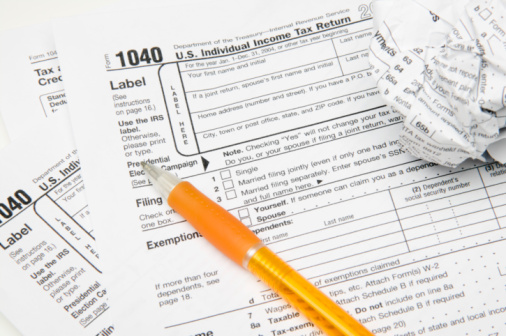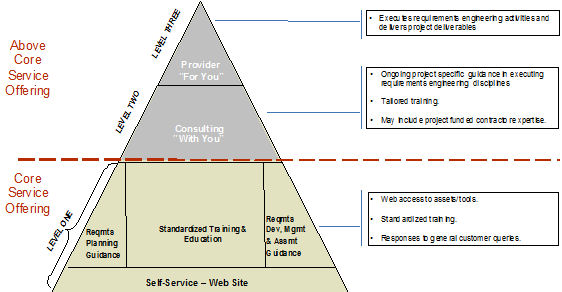Summary
This article chronicles how the Internal Revenue Service (IRS) established a centralized body of thought leaders and practitioners in order to apply a standard requirements engineering discipline across the Service. The service is applying the same rule-enhanced requirements engineering best practices and tools, developed for its own internal processes, to solve the challenge of consistent, large scale dissemination of these requirements.
A Foundation for Success
As part of its goals to improve both customer service and tax compliance, the IRS has been engaged in major modernization of its aging portfolio of core tax systems and in the development of significant new electronic services for taxpayers. Early lessons learned analysis demonstrated that for systems modernization to succeed, the IRS would need to improve its requirements specification and management practices. To address that need, the IRS Modernization and Information Technology Services organization stood up the Business Rules and Requirements Management Division (BRRM). This division’s mission is to improve requirements engineering across the IRS.
By applying industry best practice and expertise, refining these through extensive prototyping, incorporating project lessons learned and integrating business process and rule modeling, BRRM succeeded in developing improved requirements engineering guidance and standards across a number of core disciplines including:
- Requirements elicitation
- Business modeling, including business rules
- Requirement statements
- Bi-directional requirements traceability
- Verification and validation
- Impact analysis and change management
To support the institutionalization of these practice improvements, BRRM instituted a tiered service delivery model—from self-service to “BRRM does it for you,” and established a well-defined, web-based “Front Door” process for projects to follow in order to obtain guidance and assistance.
Figure 1
The Challenge
In February 2008, BRRM began a rollout of this requirements engineering guidance across the entire IRS portfolio. The issue of scale was evident. Consider that the IRS has more than 500 systems officially listed in its enterprise architecture. Many of the core systems date back decades and are currently the focus of an intensive systems modernization effort. Moreover, projects typically needed assistance in understanding how to tailor and execute the requirements engineering work products and activities in a way that fit their particular project. The challenge was to provide fit-to-purpose, yet consistent guidance to such an extensive portfolio, and do it in a way that allowed the projects to ramp up quickly.
The Solution
What was needed was a rapid, repeatable process for providing requirements engineering tailoring and execution guidance. To accomplish this, BRRM applied the very practices and tools it was seeking to disseminate. Using a rule enhanced approach to analyze the project tailoring process, BRRM developed a set of rule-driven criteria for tailoring a project’s requirement engineering activities and work products, along with guidance on their execution. But it did not stop there. The resulting rules were implemented (and initially authored) in a rule-based application using Oracle® Policy Modeling and Oracle Policy (formerly Haley™ Office Rules).
The result? An automated Question & Answer based tool that can be applied by coaches and/or projects directly to provide project tailoring and assistance. BRRM’s reach in supporting projects was extended and flexibility achieved at the project level within the context of a consistent, repeatable process managed by BRRM.
The Requirements Engineering Tailoring Application
The Requirements Engineering Tailoring Application presents questions to projects in an interview-like format. The goal is to solicit information on the accomplished and anticipated work the project expects to perform. The questions behind the project characterization form the base-level rule premises. Conclusions are drawn as the project progresses through the interview cycle. Embedded help for each question and on-demand reporting supports self-assisted guidance and reporting of tailoring recommendations.
The posed questions dynamically change during the interview cycle to fit the characterization being formed for the project and probe for information at varying depths based on answers given to preceding questions. The application gathers information in the following areas:
- Scope Definition
- Process Modeling
- Rule Development
- Organization Modeling
- Location Modeling
- Data, Application, and Technology Modeling
Information across these areas is interpreted by the underlying rules to establish recommendations for completing scope, developing plans, performing modeling and producing deliverables.
Projects may not know the answer to a posed question, and may choose to leave a question unanswered. These unanswered questions represent areas of “uncertainty” within the project. The degree of uncertainty is evaluated by the rules and used to generate recommended activities to reduce potential project risks posed by these uncertainties.
Tailoring Tool Outputs
Based on project-provided characteristics and subsequent conclusions drawn by the rule base, the application provides the project with a set of recommended requirements engineering activities and deliverables. Application outputs are available either on screen or as printed reports and include:
- A summary report providing bottom-line information on recommended high-level activities and deliverables to achieve a balanced and complete requirements engineering approach.
- For each recommended deliverable, detailed content guidance supplements the general guidance provided in deliverable templates.
- Recommended Work Breakdown Structure (WBS) activities that supply the project with a set of requirements engineering activities to use for the project’s overall schedule. Descriptions supplement each WBS activity to provide clarity of purpose and implementation.
- A type of “why” report, enabled by the rule-based nature of the application, provides justification for the recommendations based on the project self-characterization.
- A report of all posed questions with project answers. This report may be kept for project archives or used as a checklist for completing unanswered questions.
Benefits Achieved
Using an off-the shelf package was an efficient, cost-effective mechanism for developing and the disseminating BRRM’s tailoring rules/guidelines. The tailoring application allowed BRRM to make a “virtual coach” available to all projects, thereby maximizing available personnel and increasing guidance promulgation. Providing a consistent and repeatable process is a cornerstone for any organizational process implementation and improvement program. The rule-driven tailoring application supports this ideal, and enhances BRRM’s alignment with recognized industry standards such as the Capability Maturity Model Integration (CMMI) and Information Technology Infrastructure Library (ITIL).
Benefits to the projects include:
- Objective and consistent requirements engineering tailoring recommendations
- Specific requirements engineering and tailoring recommendations from a single application, thus reducing the need to search across various areas of organizational guidance
- A self-assist model that helps ensure accessibility of guidance to the project
- A basis for objective quality assurance at review points and milestones
The Future
The success of the Requirements Engineering Tailoring Application has extended well beyond the benefits it has provided to projects, who have welcomed it, and to BRRM, through its flexible yet repeatable reach approach to guidance delivery. The rule driven clarity it has brought to requirements engineering at the IRS has helped identify and spur further improvements in project specification standards and process streamlining opportunities.
The initiative has stirred the interest of other IRS standards organizations that provide guidance to projects. The tool and the approach it embodies have become enablers for better integration across all these standards and disciplines.
It is anticipated that the Requirements Engineering Tailoring Application will continue to evolve and the scope of “one-stop” project guidance will continue to expand. All players stand to win: the projects themselves, the larger program and architecture owners, the standards bodies that guide them both, and, as a result, the agency as a whole and ultimately the American taxpayer.


















